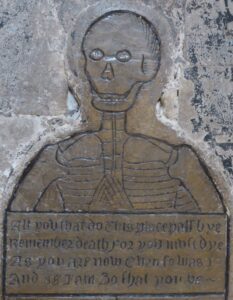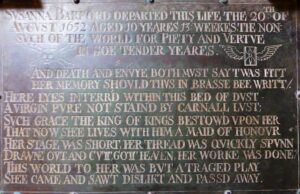

The top section of Thomas Gooding’s memorial at Norwich cathedral (see below or click image for source and acknowledgements etc., ref. Image 1).
There’s a memorial in Norwich cathedral (see image on the right) that expresses similar sentiments to Francis Greene’s. It’s brief and to the point, less obscure in its language than Francis’ message (again, punctuation added and case altered for ease of reading – spelling left like the original for interest):-
‘All you that do this place pass bye,
remember death for you must dye.
As you are now even so was I,
and as I am so shal you be.
Thomas Gooding here do staye,
wayting* for God’s judgment daye.’
Note: salvation in the judgement mentioned here does not depend on our good works, since on that basis we would all be declared guilty, because we are (see the comments on Francis Greene’s will). It depends on whether we have trusted in Jesus’ death on our behalf in the face of that guilt, and so are acquitted for a share in His reward, as we follow Him – which is both evidence and effect of that trust. Following Him leads through death (which, as these ‘tomhes’ are keen to point out, is relatively soon) into eternal bliss*. They might sound quite negative, but

Susanna Barford’s memorial from 1652, on a brass plaque inside Southwark Cathedral (see below or click image for source and acknowledgements etc., ref. Image 2).
that’s not their aim: the point is that we’re to consider what to do about our impending deaths, which they assume any readers will understand. These memorials are a wake-up call, spoken by the ‘dead’ to the ‘living’! – or perhaps the other way round spiritually? – in love, and hope (bluntly!).
In Southwark cathedral (see image on the left) there’s another ‘traged’ but rather beautiful rhyming memorial, which also seems rather blunt, yet with quite a Shakespearean ring to it, which is interesting given its location (again, punctuation added and case altered for ease of reading – spelling left like the original for interest):-
‘Susanna Barford departed this life the 20th of August 1652 aged 10 yeares 13 weekes
The non such of the world for piety and vertue in soe tender yeares.
And death and envye both must say twas fitt,
her memory should thus in brasse bee writt.
Here lyes interr’d within this bed of dust,
a virgin pure not stained by carnall lust.
Such grace the King of kings bestow’d upon her,
that now shee lives with him a maid of honour.
Her stage was short, her thread was quickly spunn,
drawne out and cutt, gott heaven, her worke was done.
This world to her was but a traged play,
she came and saw’t dislik’t and passd away.’
The phrase ‘her thread was quickly spunn’ is particularly thought provoking. It carries with it the idea that our lives are unique threads ‘cutt’ at varying lengths (whether short or long, in relatively no time we’ll all be in Susanna’s position). This can also be linked to the idea that our lives are part of a tapestry. It’s often been said that we only see the back of this tapestry, which can seem messy and confusing. God sees the other side, and so one day will we. Who knows what part Susanna Barford’s short thread is playing on the other side of this tapestry? Perhaps her thread is a glint in God’s eye, looking piercingly back at us as we consider her memory ‘in brasse writt’? As the old hymn by Charles Wesley goes: ‘Thine eye diffused a quickening ray, I woke, the dungeon flamed with light; My chains fell off, my heart was free, I rose, went forth, and followed Thee’. Perhaps that’s God’s purpose for some who click on this page and are set thinking?
* the fact that he can be both waiting for judgement and at the same time with God is a theologically complex issue, and so not discussed in detail here on this website, which is about the medical history of Newmarket and explaining the main historical characters in that play. However, the author of this website believes that the fact that both God and eternity are in a sense outside of time might have more relevance to this subject than has traditionally been realised.
Back to the page on Francis Greene.
Image sources and acknowledgements:-
Image 1: Photograph taken in 2019, by the author of talkingdust.net.
Image 2: Photograph taken in 2013, by the author of talkingdust.net, used here with kind permission of the Dean and Chapter of Southwark cathedral, 2019. [Note: such permission is mentioned with this image since Southwark cathedral has a photo permit system, although I don’t recall that being in place when I took the image in 2013, nevertheless permission has been sought and granted to use the image here to be cautious.]
Note: see comments regarding images and copyright © etc. on the Usage &c. page as well.